Autumn is here and it is time to enjoy fall foliage colors in the US. The trees around your place must be already best in their colors – yellow, brown and red. I am personally enjoying those hues of fall. The fall colors are dependent on the mositure, amount of the rainfall and transition to colder weather. The green leaves gradually turns into yellow and then brown/red and fall away from the trees. The word ‘fall’ resembles the falling on the leaves from the trees.
I have been googling for the fall foliage places in-and-around NJ for quite a few weeks now. Also visited few places and thus writing this post.
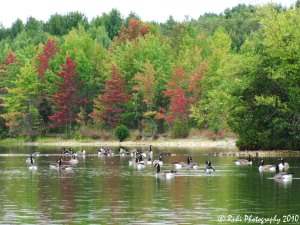 1. Plainsboro Preserve – To my surprise this heaven is closest to my place. It is a wonderful place not just to cherish fall colors but ‘nature’ overall. There is a huge water body and forest with loads of varieties of flora and fauna including birds. There are short and long nature trails. I enjoyed the ‘Maggi trail’ as it takes you on the path which is surrounded by water on both sides at dead end. And I feel short of words to express how it feels to be there.
1. Plainsboro Preserve – To my surprise this heaven is closest to my place. It is a wonderful place not just to cherish fall colors but ‘nature’ overall. There is a huge water body and forest with loads of varieties of flora and fauna including birds. There are short and long nature trails. I enjoyed the ‘Maggi trail’ as it takes you on the path which is surrounded by water on both sides at dead end. And I feel short of words to express how it feels to be there.
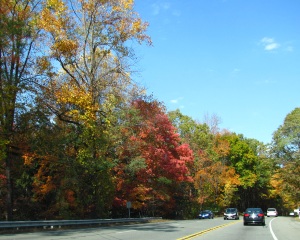 2. Lake Hopatcong State Park – Thanks to my GPS which headed me to US route 206. The route itself is full of fall colors. Lake Hopatcong state park was in shades of green, brown and yellow. Maple trees were awesome. What I liked about the places is – there is a artifical short sand beach around the lake at park side, with some sliders and swings n stuff for kids. The good place for family outing. Get your food packed and eat on the benches under the fall trees.
2. Lake Hopatcong State Park – Thanks to my GPS which headed me to US route 206. The route itself is full of fall colors. Lake Hopatcong state park was in shades of green, brown and yellow. Maple trees were awesome. What I liked about the places is – there is a artifical short sand beach around the lake at park side, with some sliders and swings n stuff for kids. The good place for family outing. Get your food packed and eat on the benches under the fall trees.
3. D & R Canal State Park – The Delaware and Ranitan state park path runs along the flowing canal to the deep woods. Good place for biking and nature trail. You can see lot of deers. Very much into the city and easily accessible from Route 27.
Also people say that there are chances of citing good falls colors this year at places like – High Point State Park, Split Rock Reservior in Rockaway, Monksville Reservior too. So guys…enjoy fall colors this season! 🙂

Posted in Bird watching, Fall foliage, Nature, Photography, Travelogue, Wildlife | Tagged autumn, D & R state park, fall, fall colors, Fall colors around NJ, fall colors in NJ, Fall foliage, fall foliage in NJ, fall in NJ, forest, Highpoint State Park, Hopatcong, Lake Hopatcong, Lake Hopatcong State park, leaves, maple, maple trees, Monksville reservior, Nature, new jersey, New jersey fall, nj, Plainsboro preserve, plainsboro preserve NJ, rockaway, route 206, Route 206 falls, Split rock reservior, State Parks, trees, US | 1 Comment »
I badly needed a ‘bhatanki-break’ to kill my boredom. On saturday night, I started hunting for a place to drive and suddenly ‘Lavthaleshwar’ stuck my mind. Actually ‘Lavthaleshwar’ needs to be clubbed with Jejuri as it is 1-1.5kms just before Jejuri but i had not been there earlier in my Jejuri visits. It is known to be an ancient cave temple of Lord Shiva. I felt keen desire to visit here. I got up early in the morning and took up Solapur highway.
To reach Lavthaleshwar:
- Take Solapur highway
- Drive up to Hadapsar and take right turn to Saswad.
- On the way to Saswad, you have to cross Dive ghat.
- From Saswad, take road to Jejuri.
- 1.5 kms before Jejuri, look for ‘Lavthaleshwar’ temple entrance on right hand side.
- Total distance from Pune is around 48 Kms.
It is good drive of around 50 kms to reach the temple. Amazing fact about this place is – the temple is underground and not easily seen from road side. I parked my vehicle near the entrance name and literally searched for the temple. Later found some deep steps leading to the temple door. I descended and found this cave temple. Another unique thing about ‘shiva-linga’ was, it was placed perpendicular to the entrance of ‘gabhara’. Mostly shiva lingas are horizontally placed in ‘Gabhara’. Being cave temple, it was cooler inside. I bowed in front of almighty and sat in peace. I generally like to visit temples in off-season where in I can spend my own sweet time there and conversing with God in leisure. This time it was exactly same. Then I came outside the temple and spent some time observing the surroundings. It was peaceful and shady.
It is said that Swami Ramdas on the way to Jejuri halted at this temple overnight. He composed famous Pooja Arati – “Lav lavathi vikrala brahmandi mala…” here derived from the name ‘Lavthaleshwar’.
I started my return journey, took a ‘Misal paav’ break in Saswad. It was good drive of 60 odd kms and the place was worth visiting.
Lavthaleshwar can be clubbed with Jejuri. For all those who want to be at peace this is THE place to be. 🙂

Posted in Heritage Places, Historical Place, Photography, Travelogue | Tagged "Lord Shankar", Around Pune, Explore Pune, God, God Shankar, Hindu, Hindu temples, Lavthaleshwar, Lawthaleshwar, Lord Shiva, Near Jejuri, Outings, Pune, Shankar, Shankar temple, Shiva, Shiva linga, Shiva temple, Shivalinga, Temple | 4 Comments »
We made a plan to visit Sinhagad valley and left home by 6:30 am. We reached valley and saw ‘Changeable Hawk Eagle’.
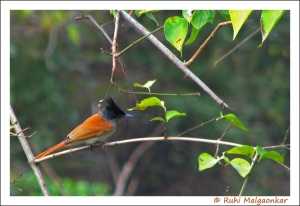 The main attraction of this time was ofcourse, Paradise Flycatcher and we disbursed to take up the positions in the patch of the valley where these birds are ought to be found. The wait was on…
The main attraction of this time was ofcourse, Paradise Flycatcher and we disbursed to take up the positions in the patch of the valley where these birds are ought to be found. The wait was on…
After some time, I found Paradise female coming in. I was happy to see it. It jumped from one perch to another and played hide and seek with us. I enjoyed watching and clicking it.
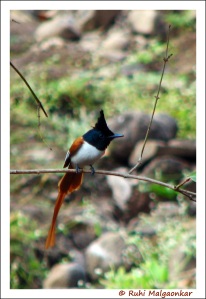 The next was, a juvenile Paradise flycatcher male. This was beautiful orange bird with long tail which added to its grace. I tried to click as many frames as I could. It approached water and started enjoying the breakfast. We drooled over its gestures as it drooled on its flies feast. 😛
The next was, a juvenile Paradise flycatcher male. This was beautiful orange bird with long tail which added to its grace. I tried to click as many frames as I could. It approached water and started enjoying the breakfast. We drooled over its gestures as it drooled on its flies feast. 😛
And finally…an exceptionally beautiful Paradise Flycatcher male made its way and gave us a ‘courtesy visit’. It was royal white and appeared truely as a bird from ‘Paradise’. It appeared before us for few minutes and so I couldn’t get chance to click any of its snaps…Thanks to few (hopeless) group of 4, whose movements and standing up in the middle of its appearance, scared away the Paradise bird.
We got to see few more birds like Fantailed Flycatcher, Yellow Wagtail, Malabar Whistling Thrush, Red-throated Flycatcher, Tickells Blue Flycatcher.
We left the valley and took ‘Misal-paav’ break at Hotel Shivanjali which is at base of the fort. My long-lasting wish of seeing Paradise birds had come true as we finally met today. 🙂

Posted in Bird watching, Photography, Travelogue, Wildlife | Tagged Around Pune, Bird Photography, Bird watching, Birds, Changeable Hawk Eagle, Fantailed Flycatcher, Maharashtra, Malabar Whistling Thrush, Paradise Flycatcher, Paradise Flycatcher female, Paradise Flycatcher juvenile, Paradise Flycatcher male, Pune, Red-throated Flycatcher, Sinhagad, Sinhagad Valley, Tickells Blue Flycatcher, Valley, valley pune, Yellow Wagtail | 3 Comments »
Exploring all those unexplored places around Pune and missing most obvious place like Balaji-Narayanpur was not done and so I made a weekend afternoon plan. Best thing about the trip was, I had my mom with me. We left home in the afteroon and took Pune-Satara highway.
To reach Balaji-Narayanpur (From Pune) –
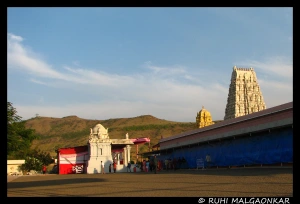 Take Pune-Satara Highway (NH-4).
Take Pune-Satara Highway (NH-4).- Travel some 35Kms to reach village ‘Kapurhol’.
- Turn left turn from here to reach village Ketkawale’.
- Travel more 12Kms to reach Balaji Temple.
Note: There is also another road to Balaji from village Saswad. Road is Pune-Hadapsar-Saswad-Narayanpur-Ketkawale(Balaji).
We reached Balaji and parked our vehicle in parking area. Balaji temple is replica of actual Tirupati Balaji temple in the south. The majestic walls in white marble and typical Gopur structure are amazingly beautiful. We joined the queue and after going through all those security measure we finally reached garbhalay. The standing idol of Balaji is royal and awesome. The upalay (surrounding area around main temple) has small temples of deities like Mahalakshmi, Padmawathi, Krishna, Kuber, etc. We took prasad and enjoyed divine and clean ambience at the temple.
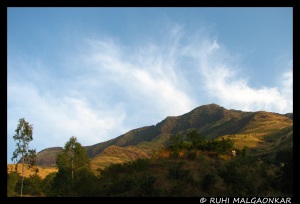 Our next destination was Narayanpur. We took the Ketkawale-Saswad road. Glimpses of Purandar made me think of Sambhaji Maharaj again. In fact, Kapurhol village itself reminded me of ‘Dharau’. Dharau was a village woman from Kapurhol who was brought to fort Purandar for feeding him (baby Sambhaji) after death of his mother Saibai. Dharau stayed with Chatrapati’s family for quite long till her old age. I accelerated down to zero and stopped by to click some snaps.
Our next destination was Narayanpur. We took the Ketkawale-Saswad road. Glimpses of Purandar made me think of Sambhaji Maharaj again. In fact, Kapurhol village itself reminded me of ‘Dharau’. Dharau was a village woman from Kapurhol who was brought to fort Purandar for feeding him (baby Sambhaji) after death of his mother Saibai. Dharau stayed with Chatrapati’s family for quite long till her old age. I accelerated down to zero and stopped by to click some snaps.
Evening became pleasant. I was driving towards east and was exceptionally beautiful sunset in the back mirror. I didn’t want to waste time by getting down and got an instant idea to capture it in my car’s mirror itself.
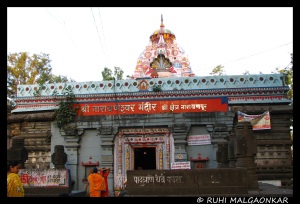 We reached Narayanpur and visited Narayaneshwar temple. This is very ancient Shiva temple and the gabhara has gupta (hidden) Shiva-linga. Above it, there is golden shiva-linga gifted to the temple by Shivaji Maharaj’s mother Jijabai. We also visited adjacent ‘Ek-mukhi (single faced) Datta’ mandir. The standing idol of Lord Datta is worth seeing.
We reached Narayanpur and visited Narayaneshwar temple. This is very ancient Shiva temple and the gabhara has gupta (hidden) Shiva-linga. Above it, there is golden shiva-linga gifted to the temple by Shivaji Maharaj’s mother Jijabai. We also visited adjacent ‘Ek-mukhi (single faced) Datta’ mandir. The standing idol of Lord Datta is worth seeing.
We started our return journey and took a ‘wadaa-paav’ break at famous ‘Joshi Wadewale’ near Khed-Shivapur village. It was quick and content trip.

Posted in Heritage Places, Historical Place, Photography, Travelogue | Tagged "Shivaji Maharaj", "Lord Shankar", “Sambhaji Maharaj”, पुरंदर, पुरंदर किल्ला, Balaji, Chatrapati Sambhaji Maharaj, Datta, Datta mandir, Dharau, ek-mukhi datta, Fort, Fort Purandar, Jijabai, Kapurhol, Ketkawale, Lord Shiva, Mandir, Narayaneshwar temple, Narayanpur, Purandar, Sambhaji, Saswad, Shiva, Shiva linga, Shiva mandir, Shivaji | 12 Comments »
November 18, 2009 by Ruhi
Reverse monsoon (November rain) is not a pleasant thing anymore. Moreover as it was accompanied with storms, cyclone Phyan and what not. Rains made the days dull and lazy. Weekdays were spent in the office and then came weekend.
My friend wanted to capture clouds/fog for time lapse in Mulashi-Tamhini and I decided to accompany him. (Don’t ask me about time lapse stuff, i dont know any technicalities of it but i can now understand and identify it visually. )
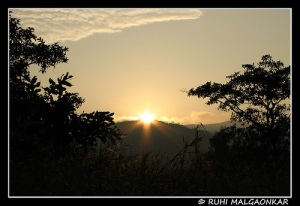 ‘Mulashi+Tamhini+rains’ equation is always delightful and also we both didn’t meet for quite some time. These reasons were good enough to catch up. We started at 5:30 AM. Plan was to reach there before sunrise but we couldn’t speed up much, many thanks to worst road condition.
‘Mulashi+Tamhini+rains’ equation is always delightful and also we both didn’t meet for quite some time. These reasons were good enough to catch up. We started at 5:30 AM. Plan was to reach there before sunrise but we couldn’t speed up much, many thanks to worst road condition.
Somewhere near Mulashi, we found a wild cat crossing the road. We slowed down to watch it. It stood up to see how are we to focus lights in its eye, it gave us a dirty look and walked away. It was still dark morning. As darkness began to vanish slowly we found the road to be foggy and road-side puddles gave us evidences of rains. Few miles later, we stopped the car and my friend showed me 1st new bird of the trip. It was ‘Pied Crested Cuckoo’ (मराठी: ‘चातक’). It was busy enjoying its morning breakfast. It is said that Pied-crested Cuckoo sights are sign that monsoon are in. This is migratory bird which travels from South Africa to India. He waited for while and proceeded ahead.
We halted in Tamhini ghat for sunrise. Lord Sun slowly rose from back of the mountains, generously spreading its rays on the earth, fading away all the darkness and making the morning pleasant and worth while. We took some snaps and drove till Plus valley. There was no fog and clouds rising from valley so my friend was not able to capture time lapse. There were few rain showers in the mid.
We came across an animal which was killed by the road vehicles. The animal was ‘Small Indian Civet’. It was sad to see this rare-cited animal getting killed in such inhuman way. 😦
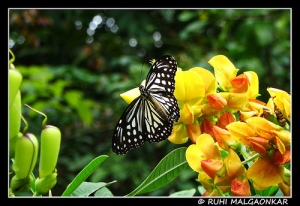 We traveled some more and waited at a spot. We did hear some calls of birds and giant squirrel ‘Shekru‘. And also tremendously beautiful pair of Scarlet Minivets had caught our attention. He parked our car at road side and went to woods. The pair also had their baby with them. I must say Scarlet Minivet male with its red and black color is one of the most colourful birds I have seen in India. The female is none less and is yellow-black with some patches of grey on wings. We silently stood at trees. I was seeing them for first time and all I wanted to do is watch them. Needless to say, thanks to my wildlife expert friend who knows all about birds, wildlife and immediately identifies them.
We traveled some more and waited at a spot. We did hear some calls of birds and giant squirrel ‘Shekru‘. And also tremendously beautiful pair of Scarlet Minivets had caught our attention. He parked our car at road side and went to woods. The pair also had their baby with them. I must say Scarlet Minivet male with its red and black color is one of the most colourful birds I have seen in India. The female is none less and is yellow-black with some patches of grey on wings. We silently stood at trees. I was seeing them for first time and all I wanted to do is watch them. Needless to say, thanks to my wildlife expert friend who knows all about birds, wildlife and immediately identifies them.
Another attraction was loads and loads of colourful butterflies. I enjoyed seeing and clicking them too. We started our return journey at 11:30 and took a ‘Quick bite’ break while returning.
Mulashi-Tamhini and its wildlife treat is full of many such surprises and too irresistible to miss.

Posted in Bird watching, Photography, Travelogue, Wildlife | Tagged Around Pune, Bird watching, Birds, Chaatak, Clouds, Explore Pune, Fog, Greenery, Marathi-Chaatak, Monsoon, Mulashi, Mulashi sunrise, Paud, Pied Crested Cuckoo, Pirangut, Pirangut ghat, Pune, Rains, Rainy outing, Reverse monsoon, Road to heaven, Scarlet Minivet, Scarlet Minivet Female, Scarlet Minivet Male, Sunrise, Tamhini, Tamhini ghat, Waterfall, Wilde Cat, Wildlife | 1 Comment »
This was my second visit to Panhalgad a.k.a Panhala. We reached Panhala in the afternoon and still the weather was pleasantly cool on the top. First visit was more of ‘khao-pio-maja karo’ types. I made it a point to hire a guide this time, who could explain and give the historical information about the fort.
To reach Panhalgad (from Kolhapur):
- Take Kolhapur-Ratnagiri highway (NH204)
- Travel some 20-25 Kms to reach the base of the fort.
- Take the road to the top.
- Car is allowed inside the fort and you can see different places on this fort by driving your own vehicle.
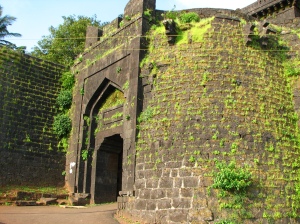 About Panhalgad (मराठी: पन्हाळा, पन्हाळगड), also known as ‘Panhala’or ‘Panhalla’ or ‘Panalla’ which literally means ‘home of the serpents’. The Shilahara king Bhoja II between 1178 and 1209 CE built Panhala fort. The Yadavas defeated Raja Bhoja and captured this fort and then through changing hands it came to Adilshah of Bijapur. In 1659, Shivaji Maharaj defeated Bijapur general Afzal Khan and conquered Panhalgad. In May 1660, Adil Shah II sent his uncle Siddi Johar to lay siege to Panhala. Siddi Johar came with huge army and the siege continued for 4 months. At the end of which all provisions in the fort were exhausted and Shivaji Maharj was on the verge of being captured. Also there was no enough force to fight against Johar and his army.
About Panhalgad (मराठी: पन्हाळा, पन्हाळगड), also known as ‘Panhala’or ‘Panhalla’ or ‘Panalla’ which literally means ‘home of the serpents’. The Shilahara king Bhoja II between 1178 and 1209 CE built Panhala fort. The Yadavas defeated Raja Bhoja and captured this fort and then through changing hands it came to Adilshah of Bijapur. In 1659, Shivaji Maharaj defeated Bijapur general Afzal Khan and conquered Panhalgad. In May 1660, Adil Shah II sent his uncle Siddi Johar to lay siege to Panhala. Siddi Johar came with huge army and the siege continued for 4 months. At the end of which all provisions in the fort were exhausted and Shivaji Maharj was on the verge of being captured. Also there was no enough force to fight against Johar and his army.
The only option left with Shivaji Maharaj was an escape from the fort. With few trusted soldiers and his commander Baji Prabhu Deshpande, they escaped in the dead of the night to fort Vishalgad on 13 July 1660. Another troop with Shivaji’s barber, Shiva Kashid, who resembled like Shivaji in his looks, kept the enemy engaged, giving them an impression that Shiva Kashid was actually Shivaji. Shiva Kashid was caught and killed immediately after the truth was known. Furious Siddi Johar sent his army to chase Shivaji.
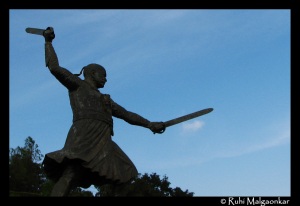 At the pass through the mountains, called ‘Ghod Khind’ (‘khind’ means ‘narrow pass in mountainous terrain’, ‘Ghod Khind’ means Horse Pass – literally through which only a single horse could pass) Baji Prabhu let Shivaji Maharaj proceed towards fort Vishalgad and fought a battle with 300 odd men against Siddi Johar’s army in thousands. He fought bravely till he heard the cannon firing from fort Vishalgad, which was signalling that Shivaji has reached safely. Baji Prabhu fought relentlessly, at times with swords in both hands. He breathed his last along with many great men of Shivaji like Sambhaji Jadhav, Bandals, etc.
At the pass through the mountains, called ‘Ghod Khind’ (‘khind’ means ‘narrow pass in mountainous terrain’, ‘Ghod Khind’ means Horse Pass – literally through which only a single horse could pass) Baji Prabhu let Shivaji Maharaj proceed towards fort Vishalgad and fought a battle with 300 odd men against Siddi Johar’s army in thousands. He fought bravely till he heard the cannon firing from fort Vishalgad, which was signalling that Shivaji has reached safely. Baji Prabhu fought relentlessly, at times with swords in both hands. He breathed his last along with many great men of Shivaji like Sambhaji Jadhav, Bandals, etc.
Ghod Khind was covered with blood of 300 Marathas who willingly gave up their lives and fought to the last man for the cause of freedom. The pass was then renamed as ‘Pavan Khind’ which means ‘Sacred Pass’ and known for sacrifice and bravery of Baji Prabhu Deshpande and his men in Maratha history.
The fort went to Adil Shah. Finally and permanently Shivaji occupied the fort in 1673. Panhala fort housed 15,000 horses and 20,000 soldiers in Shivaji’s rule.
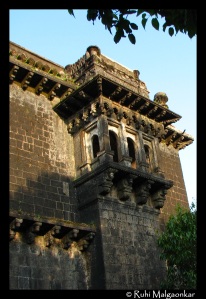 Much later, Sambhaji, Shivaji’s son was kept under house arrest in Panhala fort. He escaped from here along with his wife on 13 December 1678 and attacked Bhupalgad. He returned to Panhala, however, on 4 December 1679 to reconcile with his father, just before his father’s death on 4 April, 1680. The fort remained with Chatrapati Sambhaji Maharaj, Chatrapati Rajaram, Tarabai and Chatrapati Shahu until it went to British and now belongs to Government of India.
Much later, Sambhaji, Shivaji’s son was kept under house arrest in Panhala fort. He escaped from here along with his wife on 13 December 1678 and attacked Bhupalgad. He returned to Panhala, however, on 4 December 1679 to reconcile with his father, just before his father’s death on 4 April, 1680. The fort remained with Chatrapati Sambhaji Maharaj, Chatrapati Rajaram, Tarabai and Chatrapati Shahu until it went to British and now belongs to Government of India.
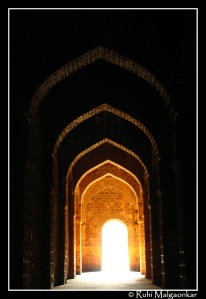 Awesome statue of Baji Prabhu Deshpande is erected at the entrance of the fort. Our guide took us to different places of interest like – Tabak udyan, Andhar Baav (hidden well to protect drinking water from getting poisonated), Someshwar temple, Teen Darwaza, Raj Dindi bastion, Sajja Kothi (where Sambhaji was kept under house arrest), ancient Hanuman temple, Rani Tarabai’s palace, Ambabai temple, Kalavantin Sajja, Ambarkhana (Graineries and commodities storage), Dharmakothi (from where donations were done to poor and needful), Teen Darwaja, Wagh Darwaja, Someshwar temple, etc. The fort is one of the largest forts in Deccan with perimeter of 14 km, 100+ lookout posts, 2772 feet above sea level and 400m above the surroundings with more than 7 km of fortifications (Tatabandi). Views of Jyotiba, Konkan, Masai Pathar from the top of the fort are amazing.
Awesome statue of Baji Prabhu Deshpande is erected at the entrance of the fort. Our guide took us to different places of interest like – Tabak udyan, Andhar Baav (hidden well to protect drinking water from getting poisonated), Someshwar temple, Teen Darwaza, Raj Dindi bastion, Sajja Kothi (where Sambhaji was kept under house arrest), ancient Hanuman temple, Rani Tarabai’s palace, Ambabai temple, Kalavantin Sajja, Ambarkhana (Graineries and commodities storage), Dharmakothi (from where donations were done to poor and needful), Teen Darwaja, Wagh Darwaja, Someshwar temple, etc. The fort is one of the largest forts in Deccan with perimeter of 14 km, 100+ lookout posts, 2772 feet above sea level and 400m above the surroundings with more than 7 km of fortifications (Tatabandi). Views of Jyotiba, Konkan, Masai Pathar from the top of the fort are amazing.
The replica fort called ‘Pawangad’ lies adjacent to Panhalgad. It has ‘Tupachi Vihir’ (ghee well) i.e. a well built for specially for storing ghee. In olden times, a well was used to store and decompose ghee, which was later used as an antiseptic for injured soliders. Application of this ghee on wounds created intense burning sensation but avoided turning septic and healed faster. Apart from Pawangad only forts Ajinkyatara and Purandar have the remains of such wells and Ranjan (a large earthen water-jar).
Panhalgad and Pawangad forts together stand today depicting magnificent history of India. While descending, I again halted at statues of Baji Prabhu and Shiva Kashid for few moments. Panhalgad once again gave me a chance to experience and remember the history of great Shivaji Maharaj and his men who made Maharashtra.

Posted in Heritage Places, Historical Place, Photography, Travelogue | Tagged "Chatrapati Shivaji Maharaj", "Shivaji Maharaj", Adil Shah, Ambabai temple, Ambarkhana, Andhar Baav, पन्हाळगड, पन्हाळा, Baji Prabhu, Baji Prabhu Dehspande, Bandal, Bandals, Bastions, Battle, Battle of Pavankhind, Bhoja II, Bijapur, Chatrapati Rajaram, Chatrapati Sambhaji Maharaj, Chatrapati Shahu Maharaj, Deccan, Dharmakothi, Fort, Fortification, forts, Ghee Well, Ghod khind, Graineries, Hanuman temple, Hindavi Swarajya, Hindu, History, History of India, India, Jyotiba, Kalavantin Sajja, Khind, King, Konkan, Maharashtra, Maratha, Masai Pathar, Panalla, Panhala, Panhala Siege, Panhalgad, Panhalla, Pavan khind, Pawangad, Pawankhind, Raj Dindi bastion, Raj dindi marg, Raja Bhoj, Rani Tarabai, Rani Tarabai’s palace, Sajja Kothi, Sambhaji's house arrest, Shilahara ruler, Shiva Kashid, Shivaji, Siddi Johar, Someshwar temple, Swaraj, Swarajya, Tabak udyan, Tarabai, Teen Darwaja, Teen Darwaza, Tupachi vihir, Vishalgad, Wagh Darwaja, Yadavas | 7 Comments »
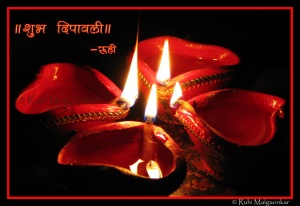
Here is wishing for all my friends and readers a very Happy Diwali and Prosperous New Year!!!
Posted in Celebrations, Festival | Tagged शुभ दिपावली, Best wishes, Celebrations, Deepawali, Diwali, Diwali 09, Happy Diwali, Hindu, Hindu Festival, India, lamps, Maharashtra, Pune | Leave a Comment »
Some places appeal so much to your heart that you get an intense desire to visit them, Khidrapur is one of such places. I came to know about this place some half an year ago and was keen to visit. Each hectic visit to Kolhapur somehow didn’t allow me to do so and this fact made the desire stronger and deep. Finally my latest trip to Kolhapur was fruitful. My sis took out time from her busy schedule and made it so.
We headed for Khidrapur in the morning. We took up road to ‘Narsobachi wadi’. It was pleasant drive through lush green fields of sugar-cane. It rained very heavily which added to the atmosphere. I found some birds like Shrikes, Brahminy Kites and Black-shouldered Kite on the way.
To reach Khidrapur (from Kolhapur):
- Take Kolhapur-Miraj Highway.
- Cross small villages like Dharma-nagar, Chipri, Shahu Nagar, and Shirol to reach Narsobachi wadi.
- From Narsobachi wadi, take road of Kurundwad and then via Sainik Takli reach Khidrapur village.
- Ask for ‘Kopeshwar Temple’.
- Approx distance is 60-65 Kms.
We reached Khidrapur. It is very small village with farming as primary occupation.
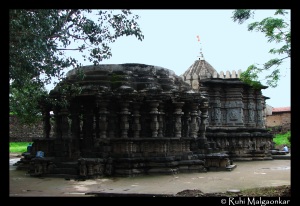 As I parked my car, I got few early glimpses from road. This magnificent temple belongs to Lord Shiva, and named as ‘Kopeshwar’. I crossed the old stone entrance which brought us to temple vicinity. Kopeshwar reminded me of wonderful architectural carvings temples of Halebidu and Bellur. It is believed that Kopeshwar temple was built by three generations of kings, the Shilahar kings Gandaraditya, Vijayaditya and Bhoj-2 between 1109 and 1178 AD. There are Devanagri writings in the temple to support this. It’s also one of the few temples where both the Shaivas and Vaishnavas, who are arch rivals, come together in worship.
As I parked my car, I got few early glimpses from road. This magnificent temple belongs to Lord Shiva, and named as ‘Kopeshwar’. I crossed the old stone entrance which brought us to temple vicinity. Kopeshwar reminded me of wonderful architectural carvings temples of Halebidu and Bellur. It is believed that Kopeshwar temple was built by three generations of kings, the Shilahar kings Gandaraditya, Vijayaditya and Bhoj-2 between 1109 and 1178 AD. There are Devanagri writings in the temple to support this. It’s also one of the few temples where both the Shaivas and Vaishnavas, who are arch rivals, come together in worship.
The mythological story behind the name ‘Kopeshwar’ is – Devi Sati (daughter of King Daksha) was married to lord Shiva. Daksha didn’t like in son-in-law at all. He was about to perform some yagna (hindu ritual performed along with holy fire) and he didn’t invite Sati & Shiva. Devi Sati felt sad and went to meet her father asking the reason behind not inviting her husband. In turn, King Daksha insulted Shiva and it was unbearable for Sati to tolerate her husband’s insult. She jumped in the yajna. Hearing this news, Shiva was furious and he punished Daksha by cutting his head. Later on, due to request of other deities, Shiva took back the curse and granted him life with goat’s head. It is believed that angry Shiva was brought to this place (temple) to cool his anger. Hence the temple got its name i.e. ‘Kop’ means anger and ‘Eshwar’ means lord Shiva.
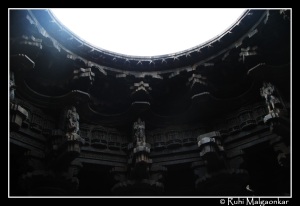 Temple stand firm with all its glory of stone carvings of 95 elephants and 108 pillars and hundreds of sculptures depicting scenes about from the Mahabharata, Ramayana, Shiva, the twelve astrological signs and flowers, trees, birds, human figures. As you step into the beautiful Swarga Mandap, you can actually feel the coolness. There are 12 superbly carved pillars which support the stone ceiling that is open to the skies. There is a beautiful round black stone slab at the centre which is called the ‘rangshila’. It is an amazing experience to sit on the centre of the stone round open ‘akaash gavaksh’ on the ceiling and look towards the dark inner sanctum of the grabha griha with its beautiful Shiva linga. It is said that all ‘adhyaaya‘ (parts) of ‘Shivlilamrut‘ are carved on the walls of the temple.
Temple stand firm with all its glory of stone carvings of 95 elephants and 108 pillars and hundreds of sculptures depicting scenes about from the Mahabharata, Ramayana, Shiva, the twelve astrological signs and flowers, trees, birds, human figures. As you step into the beautiful Swarga Mandap, you can actually feel the coolness. There are 12 superbly carved pillars which support the stone ceiling that is open to the skies. There is a beautiful round black stone slab at the centre which is called the ‘rangshila’. It is an amazing experience to sit on the centre of the stone round open ‘akaash gavaksh’ on the ceiling and look towards the dark inner sanctum of the grabha griha with its beautiful Shiva linga. It is said that all ‘adhyaaya‘ (parts) of ‘Shivlilamrut‘ are carved on the walls of the temple.
Next comes Sabhamandap, Antaral-kaksha and Garbhagriha. The Garbhagriha is more cold and dark. The shiva linga, burning lamps make the atmosphere peaceful and divine.
I was surprised to know that there was no nandi in the temple in spite of the fact that it is Shiva mandir. This is probably one of the unique things about this place. Another unsual thing here is sanctum has lord Vishnu first and then the Shiva linga to protect it. Each visitor first sees lord Vishnu and then Shiva.
It is sad that most of the sculptures are badly damaged by Islamic invaders in the later centuries. There is a story that one of Aurangzeb’s descendants strayed when wandering around on her own and came across this temple. She loved the place so much that she refused to leave the temple complex and go with her attendants. The Mughal Emperor came personally to fetch her. She agreed to leave on the only condition that he will not harm the temple and damage its beauty and so the temple remained untouched from the otherwise merciless Aurangzeb.
Khyder Khan, a later invader supposedly mutilated the carvings on the temple and cut almost all the elephants’ trunks. There are no exact historical evidences of ‘who destroyed what’ but it is very painful to see such beauty ruined. Unfortunately, the village of Wadi-Kopeshwar later came to be known as Khidrapur after this cruel invader.
Kopeshwar temple gave me much more than I expected. It gave me peace, joy and an opportunity to appreciate my homeland. Once again I felt proud to be an Indian and lucky that I can see all this. I clicked some snaps. It is really sad that such wonders are still unknown to the tourists. Saddest part is there are no milestones or sign boards about Khidrapur. We had to wait and inquire at several places. Also there is no much information available on internet.
This ancient architectural splendor should be made popular so that more and more people of similar interests can come and visit here. Such place needs to be maintained and conserved.
I decided to take another way while returning just for sake of finding new route and took road to ‘Ichalkaranji’. A fox gave us generous visit on the way and disappeared in sugarcane fields. It rained very heavily and many huge trees were uprooted on the way. I took a bypass through small village. It was messed up too. I could see a huge line of cars in jam for about 2 Kms at least. Paul, our lab doesn’t like it, if the car stops and in few minutes his barking attracted all the kids of the village. Kids gathered around our car and tried to get his glimpses through sun control filmed windows. Whole situation seemed funny and equally irritating as Paul was getting impatient. Finally, when I was about to start my car, I opened the car windows and all kids were very happily to see our handsome black Labrador.
After testing all my patience by worst traffic jam, lengthy waiting hours at railway crossing and narrow roads, I reached Kolhapur at 8:00pm.
Kopeshwar, (yes I prefer to call it just ‘Kopeshwar’ instead of ‘Khidrapur – Kopeshwar’) is strictly no miss-miss place if you are planning a visit to Sangli, Miraj, Kolhapur and alike.
Few more snaps here – http://www.flickr.com/photos/ruhiclicks/tags/khidrapur/

Posted in Bird watching, Heritage Places, Photography, Travelogue | Tagged "Heritage of India", "Lord Shankar", Around Kolhapur, Bird, Birds, Heritage, Ichalkaranji, Jaysingpur, Khidrapur, Kolhapur, Kopeshwar, Kurundwad, Lord Shiva, Miraj, Narsobachi Wadi, Sainik Takali, Shirol, Shiva linga, Shiva mandir, Shiva temple, Temple, Travel, Travelogue, wadi | 17 Comments »
September 24, 2009 by Ruhi
My wanderer mind doesn’t allow me to sit at home on weekends. Saturday was spent in some household things and evening made me ‘outing-sick’. Yes, ‘no-outing’ syndrome can be as serious as any other syndrome… no kidding friends!!! 🙂
Question was ‘where?’- An immediate answer was “Vadhu – Tulapur”. I am always obsessed by bravery of our great second Chatrapati i.e. Sambhaji Maharaj and so these places mean so much as far as history is concerned.
I made a plan to visit Vadhu, Tulapur and Phulgaon. I got up early and started at sharp 7:00. Rising sun added to the beauty of the morning. I took up Nagar highway.
Wagholi was my first hault. We can see a Shri Wagheshwar (or Wyaghreshwar) temple (श्री व्याघ्रेश्वर) surrounded by small lake on left side of highway. Just near the temple, there is black stone moument which is ‘samadhi’ of maratha sardar called ‘Pilajirao Jadhav’. He fought and won against Nizam and worked closely with Bajirao Peshwa-I. Jadhav belonged to Wagholi and his heirs built this samadhi. ‘Jadhavgad’, now turned into ‘Kamath Resort’ near Saswad belonged to these Jadhavs. Then I headed towards Tulapur.
To reach Tulapur:
1. Take Ahmednagar Highway (SH-60) and travel till ‘Lonikand’ village.
2. Travel some more, you will see board written with Sambhaji Maharaj’s pic and take left turn to go to Tulapur village.
3. Tulapur is exactly 6 kms from here. Once you take turn, you can see MSEB power station towers. Travel on tar road to reach Tulapur. You can ask villagers for ‘Sangameshwar’ temple or simply ‘Sangam’.
4. Tulapur Sangam is on right side. There is ample parking space (yes, even for 4-wheelers).
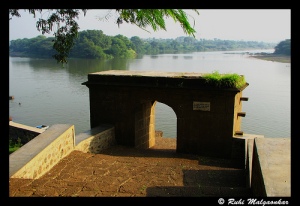 Tulapur (तुळापूर) was earlier called as ‘Naagargaon’ (नागरगाव). Adilshahi Vajir ‘Murar Jagdev’ was advised by his guru to rebuild the destructed temple of ‘Sangameshwar’ which he did. Later on, Murar Jagdev wished to donate gold as much as weight of elephant. Shahaji Maharaj gave him solution of weighing the elephant in the boat and marking the depth of boat. The boat was then refilled with stone and they were weighed and same amount of gold was donated. With this sheer intelligence of Shahaji Maharaj, Murar Jagdev could literally weigh the gold as much as an elephant. ‘Naagargaon’ was then renamed as ‘Tulapur’ i.e. ‘Weighing town’.
Tulapur (तुळापूर) was earlier called as ‘Naagargaon’ (नागरगाव). Adilshahi Vajir ‘Murar Jagdev’ was advised by his guru to rebuild the destructed temple of ‘Sangameshwar’ which he did. Later on, Murar Jagdev wished to donate gold as much as weight of elephant. Shahaji Maharaj gave him solution of weighing the elephant in the boat and marking the depth of boat. The boat was then refilled with stone and they were weighed and same amount of gold was donated. With this sheer intelligence of Shahaji Maharaj, Murar Jagdev could literally weigh the gold as much as an elephant. ‘Naagargaon’ was then renamed as ‘Tulapur’ i.e. ‘Weighing town’.
Tulapur itself must have been unaware then, of what it has to see in 3rd generation of Shahaji Maharaj. Young Chatrapati Sambhaji Maharaj (age 32) was caught in Sangameshwar, Konkan (Ratnagiri). One of his brother-in-laws, Ganoji Shirke deceived the Marathas and helped Aurangzeb’s commander, Mukarrab Khan to attack Sangameshwar when Sambhaji was in the garden, resolving some issues and was about to leave the town. With strong army of 20,000 people, Julfikarkhan moved towards Karad and then Baramati and finally to Bahadurgad near Bhima river.
Ganoji’s hunger for Maratha land in the form of watan led to his enmity with Sambhaji. Sambhaji like his father- Shivaji Maharaj had abolished the custom of giving away watans, as this led to the people’s suffering, from the hands of the watandar and there were chances of the watandars assuming kingship or taking possession of their watans.
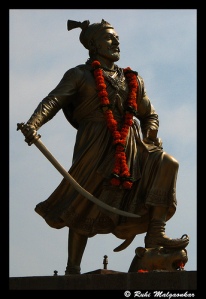 Sambhaji was tortured and executed in most cruelest way to death. He was asked to surrender his kingdom to Aurangzeb and convert to Islam religion. Sambhaji refused to convert and instead sang praises of Mahadev (Lord Shiva). Aurangzeb ordered his men to torture Sambhaji and his friend Kavi Kalash to death. Each cruel punishment was given to kavi Kalash prior to Sambhaji as if it was a rehearsal.
Sambhaji was tortured and executed in most cruelest way to death. He was asked to surrender his kingdom to Aurangzeb and convert to Islam religion. Sambhaji refused to convert and instead sang praises of Mahadev (Lord Shiva). Aurangzeb ordered his men to torture Sambhaji and his friend Kavi Kalash to death. Each cruel punishment was given to kavi Kalash prior to Sambhaji as if it was a rehearsal.
They both were dressed as clowns, with their body tied in heavy iron chains and huge wooden logs on their neck and shoulders. They were tied on camel and given a ride in village. All men and women from Aurangzeb’s troop came to see this captured Maratha warrior. People threw stones and dung at them. Their eyes were burned off with hot iron bars and tongue was plucked. They were beaten up till their wounds bleed and then were given baths of salt-water. Their skin was peeled off with ‘Wagh nakhe‘. Their legs and hands were cut off and lastly the head. Sambhaji’s body was cut into pieces and was thrown away for crows, vultures and dogs to eat. On 11 March 1689, Sambhaji was finally killed at Sangameshwar at Tulapur, near Pune. He sacrificed his life at age of 32 for ‘Dharma‘ i.e. Religion which is why he is called ‘Dharmaveer Sambhaji’.
It was the worst death anyone could get. It is truly said there was/is no king as great as Sambhaji Maharaj. No matter whether few historian portait him as spoiled brat or non-managed king or characterless or whatever, there is no actual historical proofs or evidences for their statements.
I read “Chhavaa” when i was very young and it moved me. ‘Sambhaji’, son of great Shivaji Maharaj, lost his mother at age of 2, brought up my his grand mother and the lady who made Shivaji i.e. Jijabai, at age of 10 he had mastery in 8 different languages including Sanskrit and Urdu, a soft-hearted prince, a sankrit poet, a passionate writer, a great warrior, most eligible Yuvraj, a heir who suffered from politics at home due to his step-mother Soyrabai, estranged son of Shivaji due to mis-communication and misunderstandings, our second chatrapati, one who fought with Aurangzeb and defended maratha kingdom for 12 years after Shivaji’s death without losing a single battle and the list can be endless. His multi-facet persona fascinates me like anything. I become very emotional and my eyes turn watery everytime I think of Sambhaji. Soyrabai’s own brother Hambirrao Mohite stood by Sambhaji Maharaj as he knew his sister was wrong and Sambhaji was well-deserved would-be king on Maratha throne.
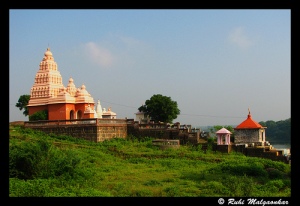 I parked my vehicle outside the small garden at Sangameshwar Temple (संगमेश्वर). There is Sambhaji’s Statue and smarak just outside the Sangameshwar temple. I visited temple and smarak; bowed in front of Lord Shiva(temple) and at Sambhaji’s statue (who I think was indeed a personified form of lord Shiva).
I parked my vehicle outside the small garden at Sangameshwar Temple (संगमेश्वर). There is Sambhaji’s Statue and smarak just outside the Sangameshwar temple. I visited temple and smarak; bowed in front of Lord Shiva(temple) and at Sambhaji’s statue (who I think was indeed a personified form of lord Shiva).
I went to Sangam ghat where 3 rivers Bhima, Bhama and Indrayani unite. There are beautiful Shri Ballaleshwar (श्री बल्लाळेश्वर) and old Ganapati temples just near the ghat. I clicked some snaps. After spending enough time, I continued my journey to Vadhu.
Phulgaon (फुलगाव):
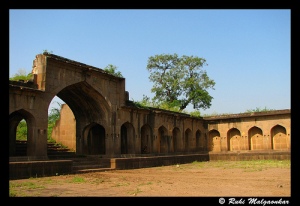 I had planned a new place in the midway i.e. Phulgaon. Phulgaon is on the road back from Tulapur to Nagar Highway. There is ‘Shrutisagar Ashram’ in Phulgaon which I visited last time. This time, I wished to see something different i.e. ‘Phulgaon ghat’. River Bhima takes a semi-circular curve at Phulgaon and a stone built wall at ghat is worth a dekko. Water was serene and it was peaceful. I climbed up the wall and sat for some time watching Pied Kingfishers, White-throated Kingfisher and Swallows. There was Peshwas palace here but now there are only ruins left.
I had planned a new place in the midway i.e. Phulgaon. Phulgaon is on the road back from Tulapur to Nagar Highway. There is ‘Shrutisagar Ashram’ in Phulgaon which I visited last time. This time, I wished to see something different i.e. ‘Phulgaon ghat’. River Bhima takes a semi-circular curve at Phulgaon and a stone built wall at ghat is worth a dekko. Water was serene and it was peaceful. I climbed up the wall and sat for some time watching Pied Kingfishers, White-throated Kingfisher and Swallows. There was Peshwas palace here but now there are only ruins left.
I started for Vadhu from Phulgaon. There is road from Tulapur from Vadhu which is in not good condition. Better is to come back to highway and go to Vadhu via Bhima-Koregaon village.
To reach Vadhu:
1. Take Nagar Highway.
2. Travel to village ‘Lonikand’.
3. Cross the Toll plaza and immediate village is ‘Bhima-Koregaon’. Toll is Rs.31/- for single journey and Rs.57/- for return.
4. Take left turn which goes to Vadhu.
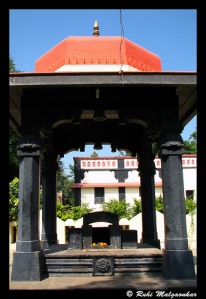 Vadhu (वढू) is the place where actual last rites (funeral) of Sambhaji Maharaj was carried out. Few brave maratha sardars from ‘Patil’ family collected the body pieces of Sambhaji and sewed them together and performed final rites at this place. They were given name ‘Shivale Patil’ for an act of this bravery. ‘Shivale’ literally means ‘Sewing’ in Marathi (मराठी: शिवले) .
Vadhu (वढू) is the place where actual last rites (funeral) of Sambhaji Maharaj was carried out. Few brave maratha sardars from ‘Patil’ family collected the body pieces of Sambhaji and sewed them together and performed final rites at this place. They were given name ‘Shivale Patil’ for an act of this bravery. ‘Shivale’ literally means ‘Sewing’ in Marathi (मराठी: शिवले) .
After few years, Sambhaji’s son Chatrapati Shahu along with his mother Yesubai came to Vadhu and gave donation to conserve this place. The statue reflecting Sambhaji’s personality is simply superb. There are Sambhaji’s and Kavi Kalash’s samadhis. I paid my tribute and started my returned journey.
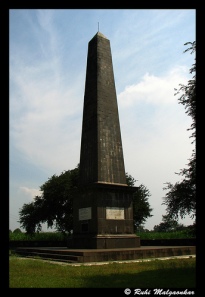 On the way back, a war monument at Bhima-Koregaon toll plaza caught my attention. I parked my vehicle and went inside. This ‘Ran-sthambh’ or war monument is erected in 1822, in the memory of soldiers who lost their lives in last British-Maratha war. Most of the soldiers where Hindu who fought from the side of British army. The soldiers’ names are carved in marble at bottom of this stone. Every 1st January ‘Mahar Regiment’ pays tribute to this war monument.
On the way back, a war monument at Bhima-Koregaon toll plaza caught my attention. I parked my vehicle and went inside. This ‘Ran-sthambh’ or war monument is erected in 1822, in the memory of soldiers who lost their lives in last British-Maratha war. Most of the soldiers where Hindu who fought from the side of British army. The soldiers’ names are carved in marble at bottom of this stone. Every 1st January ‘Mahar Regiment’ pays tribute to this war monument.
I started my return journey and reached home in the afternoon. I had been to Vadhu-Tulapur some 4 odd years ago and still can go there for n-times. Chatrapati Sambhaji Maharaj definitely deserves our respect in a form of such tribute visits!!!
For more snaps, visit – http://www.flickr.com/photos/ruhiclicks/sets/72157622293200575/

Posted in Bird watching, Heritage Places, Photography, Travelogue | Tagged "शिवाजी महाराज", "Chatrapati Shivaji Maharaj", "Maratha King", "Sambhaji Maharaj's samadhi", "Shivaji Maharaj", Around Pune, Aurangzeb, “संभाजी महाराज”, “Sambhaji Maharaj”, तुळापूर, नागरगाव, फुलगाव, वढू, व्याघ्रेश्वर, शंभूराजे, श्री बल्लाळेश्वर, संगमेश्वर, संभाजी, Bahadurgad, Bhama, Bhima, Bhima-Koregaon, Chatrapati Sambhaji Maharaj, Chatrapati Shahu Maharaj, Green, Green scene, Greenery, Hambirrao Mohite, Hindavi Swarajya, India, Indrayani, Jijabai, Julfikarkhan, Konkan, Landscape, Lord Shiva, Maharashtra, Map, Maratha, Mughals, Mukarrab Khan, Murar Jagdev, Nature, Phulgaon, Pune, Raja, raje, Rivers, Rivers in Maharashtra, samadhi, Sambhaji, Sangam, Sangameshwar, Sangameshwar temple, Shahaji Maharaj, Shahu, Shambhu raje, Shiva, Shiva linga, Shivaji, Shivaji’s son, Shivlinga, Shri Ballaleshwar Temple, Shrutisagar Ashram, Shrutisagar Ashram Phulgaon, Soyrabai, Swaraj, Swarajya, Temple, Tulapur, Vadhu, Wageshwar, Wageshwar temple, war monument, Wyaghreshwar Mandir, Yesubai, Yuvraj, Yuvraj sambhaji | 18 Comments »
September 10, 2009 by Ruhi
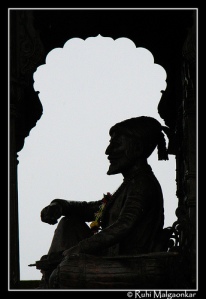 Shivaji Maharaj always fascinated me since my childhood. In fact, I liked the history because of him. I was in 3rd grade and my history teacher went an extra mile and told the class abt Sambhaji maharaj’s bravery and his heroic death and since that very moment I am completely in love with this Yuvraj…of course! Shivaji has his own share of my respect but Sambhaji still remains very close to the heart. Bottom line is – I still can’t get over my fascination for these great Marathas. 🙂
Shivaji Maharaj always fascinated me since my childhood. In fact, I liked the history because of him. I was in 3rd grade and my history teacher went an extra mile and told the class abt Sambhaji maharaj’s bravery and his heroic death and since that very moment I am completely in love with this Yuvraj…of course! Shivaji has his own share of my respect but Sambhaji still remains very close to the heart. Bottom line is – I still can’t get over my fascination for these great Marathas. 🙂
‘Raja Shivchatrapati‘ series which comes on ‘Star Pravah‘ channel added to the desire and I just wanted to visit fort Raigad. We were discussing about a place for team outing and suddenly we all were like “Raigad! Raigad!”. Finally everything was organised (yes, I and my another colleague were organizers!) and we started for Raigad on saturday early morning. Most of my colleagues had never been to Mulashi-Tamhini before and so all the excitement started from Pune itself.
To reach Raigad:
- Start from Chandani Chowk(Pune) and take Paud road.
- Cross Pirnagut, Mulashi, Tamhini ghat, Nizampur to reach‘Mangaon’.
- Take NH-17 and head towards ‘Mahaad’.
- On left hand, you will see road which goes to Raigad fort. There are huge letters ‘Raigad Ropeway’ on the hill by road side.
- Travel 25 kms more to reach village ‘Pachaad’ which is at the base of the fort.
- Total distance is approx 150 Kms.
Mulashi and Tamhini always gave me the intense feeling of nature’s treasure. Lush green, heavy rains, mist over mountains, eye-catchy view Mulashi backwaters, rain-washed road, lots of waterfalls and birds. I have so many good memories of the place. This time we took 1-2 halts in the midway but rains played the spoiled sport as far as photography was concerned. I didn’t wish to make my camera wet.
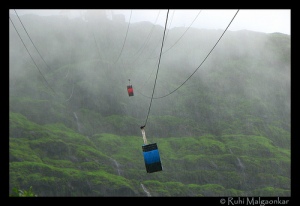 Our journery was great fun with lots of latest songs, chit-chat and stuff. We reached village ‘Pachaad’ at base of Raigad at 12. There is palace of Shivaji’s mother Jijabai here. We proceeded to ropeway base centre. We took the tickets and boarded in the cable car. It was a thrilling experience. Raigad ropeway is supposed to be steepest ropeway in Asia. As the cable car proceeded we were literally in the clouds. We were bit scared for a moment but soon the happiness took over and we started enjoying the view. Within few minutes, we were atop of the fort. Ropeway brings you to the backside of the fort. We booked the guide and then had lunch in MTDC hotel which was not so satisfying.
Our journery was great fun with lots of latest songs, chit-chat and stuff. We reached village ‘Pachaad’ at base of Raigad at 12. There is palace of Shivaji’s mother Jijabai here. We proceeded to ropeway base centre. We took the tickets and boarded in the cable car. It was a thrilling experience. Raigad ropeway is supposed to be steepest ropeway in Asia. As the cable car proceeded we were literally in the clouds. We were bit scared for a moment but soon the happiness took over and we started enjoying the view. Within few minutes, we were atop of the fort. Ropeway brings you to the backside of the fort. We booked the guide and then had lunch in MTDC hotel which was not so satisfying.
We entered Raigad fort through the ‘Mena Darwaja’. “Mena” means palkhi or palki (i.e. sedan chairs or palanquin). It was entrance to the queens and royal ladies’ palanquins. This leads to the Queens chambers, each Queen had separate chamber. The main palace was made up of wood and in front there were 3 hexagonal minars which were watch towers.
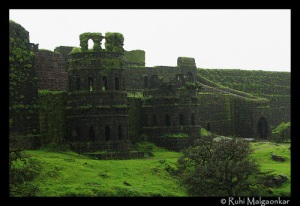 Ruins of these minars stand in front of the palace grounds overlooking an artificial lake called Ganga Sagar Lake. On other side of queens’ chambers is the residences of ‘Astha-pradhan’ means eight ministers of Shivaji. The midway leads to Shivaji Maharaj’s own palace and huge Maratha raj-darbar i.e. King’s court facing the Nagarkhana Darwaja. The newly installed Maharaj’s statue on the throne ‘Meghdambari’ is worth seeing. The unique thing about design of this court was anything spoken from any corner of the court is clearly heard at throne.
Ruins of these minars stand in front of the palace grounds overlooking an artificial lake called Ganga Sagar Lake. On other side of queens’ chambers is the residences of ‘Astha-pradhan’ means eight ministers of Shivaji. The midway leads to Shivaji Maharaj’s own palace and huge Maratha raj-darbar i.e. King’s court facing the Nagarkhana Darwaja. The newly installed Maharaj’s statue on the throne ‘Meghdambari’ is worth seeing. The unique thing about design of this court was anything spoken from any corner of the court is clearly heard at throne.
Outside the court, there is open ground called ‘Holi cha maal’ which was place for Holi festival. Adjacent to this, there are ruins of huge market place. It was designed such that one can shop even while riding or sitting astride a horse.
Another and famous statue of Chhatrapati Shivaji maharaj is erected in front of the ruins of the main market avenue that eventually leads to the Jagdishwar Mandir. Jagdishwar temple is serene and has Shivaji Maharaj’s Samadhi and also tomb of his dog called ‘Waghya’.
The main entrance to the fort is the imposing Maha Darwaja. The convoy of the king and the king himself used the Palkhi Darwaja. To the right of Palkhi Darwaja, is a row of three dark and deep chambers. Historians believe that these were the granaries for the fort.
We then headed for the execution point called Takmak Tok(point). It is a cliff from which the culprits and sentenced prisoners were thrown to their death. The area is now fenced off. This place is extremely airy and gives scary view from top. In addition to this, there are many lakes like ‘Kushavart’, ‘Kolimb’, ‘Gangasagar’, ‘Hatti Taake’, etc which were built on the fort for water supply and Bhavani temple, Khalbat-khana, Hirkani Buruj, Shirkai devi temple, residences for foreigner guests in Shivaji’s era.
Shivaji Maharaj spent most of his life on this fort i.e. about 25 years. This fort being powerful was converted into capital of Maratha kingdom. Fort evidence most of the major incidents in Maratha dynasty like coronation of Shivaji and his death. Forts like Torna, Rajgad, Kavlya and Lingana can be seen towards the East of Raigad. Towards the South are Vasota, Pratapgad and Makarandgad.
After Shivaji’s death, Raigad did see the worst of the history. Raigad, earlier known as Rairi, is obscure. In the 12th century Rairi was a seat of the Shirke-Palegar family. After changing several hands, it was captured by Shivaji from Chandrarao More in 1656 AD. Shivaji chose Rairi for his capital and renamed it as Raigad. The gigantic construction work was entrusted to Abaji Sondeve and Hiroji Indulkar. In its glory days Raigad had more than 300 houses, and structures. After Shivaji, the fort remained in the hands of Sambhaji till 1689 AD. After Sambhaji Maharaj, Zulfikarkhan a warrior of Aurangzeb won this fort by bribing the chief of the guards. He captured wife and son of Sambhaji maharaj. After Aurangzeb the fort was handed to Siddis of Janjira. They kept it with them till 26 years after the death of Aurangzeb. Bajirao Peshwe won it for Chatrapati Shahu Maharaj i.e. Marathas in 1735 AD. From Peshwas, Raigad was surrendered to the British in 1818 AD and they gave it in the captivity of forest department.
I was so excited by the fact that I was on same land where my favourite icons Shivaji and Sambhaji lived. My mind went back to Shivaji’s period and imagined him in every place I visited – his throne, his raj-darbar, queens’ chambers, Jagdishwar temple. I bowed at his throne and Samadhi. Each stone from the ruins was defending the history and for me it was no less than idol of any god. Pity! Our government is not much alert about good maintenance of such gifted treasure. 😦
It was raining like cats and dogs. I clicked as much as snaps I can while protecting my camera from rains at same time.
We decided to descend the fort in the afternoon and thought to take the stairs seemed impossible due to heavy rains and fog. We booked the tickets for ropeway and boarded in the cable car. We did miss the main darwajas (fort entrances) because of this but there is always a ‘next time’. 😀
I paid tribute to this great maratha and this great fort in my mind and bade a good-bye. Raigad was indeed an unforgettable experience!
For map of Raigad, click – http://www.flickr.com/photos/ruhiclicks/3899680852/in/set-72157622299929624/
For more snaps, visit – http://www.flickr.com/photos/ruhiclicks/sets/72157622299929624/detail/

Posted in Heritage Places, Photography, Travelogue | Tagged "जाणता राजा!", "शिवाजी महाराज", "Chatrapati Shivaji Maharaj", "Jaanata Raja", "Jagdishwar Temple", "Map of raigad fort", "Maratha King", "panch dhatu throne", "panch dhatu", "Raigad bazaarpeth", "Raigad District", "Raigad Fort", "Raigad map", "raigad minar", "Raigad nagarkhana", "Raigad photos", "Raigad samadhi", "Raja Shivchatrapati", "saat mahal", "Shivaji Maharaj", "Shivaji Maharaj's samadhi", "Tak-mak Point", "Tak-mak Tok", bazaarpeth, Clouds, Fog, Fort, Green, Green scene, Greenery, India, Jagdishwar, Konkan, Landscape, Lord Shiva, Mahad, Maharashtra, Map, Maratha, market, marketplace, minar, Mist, Mountain, Nagarkhana, Nature, Raigad, Rains, Raja, samadhi, Shiva, Shiva linga, Shivaji, Shivlinga, Travel, Tree, Trekking | 6 Comments »
Older Posts »
 1. Plainsboro Preserve – To my surprise this heaven is closest to my place. It is a wonderful place not just to cherish fall colors but ‘nature’ overall. There is a huge water body and forest with loads of varieties of flora and fauna including birds. There are short and long nature trails. I enjoyed the ‘Maggi trail’ as it takes you on the path which is surrounded by water on both sides at dead end. And I feel short of words to express how it feels to be there.
1. Plainsboro Preserve – To my surprise this heaven is closest to my place. It is a wonderful place not just to cherish fall colors but ‘nature’ overall. There is a huge water body and forest with loads of varieties of flora and fauna including birds. There are short and long nature trails. I enjoyed the ‘Maggi trail’ as it takes you on the path which is surrounded by water on both sides at dead end. And I feel short of words to express how it feels to be there. 2. Lake Hopatcong State Park – Thanks to my GPS which headed me to US route 206. The route itself is full of fall colors. Lake Hopatcong state park was in shades of green, brown and yellow. Maple trees were awesome. What I liked about the places is – there is a artifical short sand beach around the lake at park side, with some sliders and swings n stuff for kids. The good place for family outing. Get your food packed and eat on the benches under the fall trees.
2. Lake Hopatcong State Park – Thanks to my GPS which headed me to US route 206. The route itself is full of fall colors. Lake Hopatcong state park was in shades of green, brown and yellow. Maple trees were awesome. What I liked about the places is – there is a artifical short sand beach around the lake at park side, with some sliders and swings n stuff for kids. The good place for family outing. Get your food packed and eat on the benches under the fall trees.

 Take Pune-Satara Highway (NH-4).
Take Pune-Satara Highway (NH-4).
 We reached Narayanpur and visited Narayaneshwar temple. This is very ancient Shiva temple and the gabhara has gupta (hidden) Shiva-linga. Above it, there is golden shiva-linga gifted to the temple by Shivaji Maharaj’s mother Jijabai. We also visited adjacent ‘Ek-mukhi (single faced) Datta’ mandir. The standing idol of Lord Datta is worth seeing.
We reached Narayanpur and visited Narayaneshwar temple. This is very ancient Shiva temple and the gabhara has gupta (hidden) Shiva-linga. Above it, there is golden shiva-linga gifted to the temple by Shivaji Maharaj’s mother Jijabai. We also visited adjacent ‘Ek-mukhi (single faced) Datta’ mandir. The standing idol of Lord Datta is worth seeing.

 About Panhalgad (मराठी: पन्हाळा, पन्हाळगड), also known as ‘Panhala’or ‘Panhalla’ or ‘Panalla’ which literally means ‘home of the serpents’. The Shilahara king Bhoja II between 1178 and 1209 CE built Panhala fort. The Yadavas defeated Raja Bhoja and captured this fort and then through changing hands it came to Adilshah of Bijapur. In 1659, Shivaji Maharaj defeated Bijapur general Afzal Khan and conquered Panhalgad. In May 1660, Adil Shah II sent his uncle Siddi Johar to lay siege to Panhala. Siddi Johar came with huge army and the siege continued for 4 months. At the end of which all provisions in the fort were exhausted and Shivaji Maharj was on the verge of being captured. Also there was no enough force to fight against Johar and his army.
About Panhalgad (मराठी: पन्हाळा, पन्हाळगड), also known as ‘Panhala’or ‘Panhalla’ or ‘Panalla’ which literally means ‘home of the serpents’. The Shilahara king Bhoja II between 1178 and 1209 CE built Panhala fort. The Yadavas defeated Raja Bhoja and captured this fort and then through changing hands it came to Adilshah of Bijapur. In 1659, Shivaji Maharaj defeated Bijapur general Afzal Khan and conquered Panhalgad. In May 1660, Adil Shah II sent his uncle Siddi Johar to lay siege to Panhala. Siddi Johar came with huge army and the siege continued for 4 months. At the end of which all provisions in the fort were exhausted and Shivaji Maharj was on the verge of being captured. Also there was no enough force to fight against Johar and his army.
 Much later, Sambhaji, Shivaji’s son was kept under house arrest in Panhala fort. He escaped from here along with his wife on 13 December 1678 and attacked Bhupalgad. He returned to Panhala, however, on 4 December 1679 to reconcile with his father, just before his father’s death on 4 April, 1680. The fort remained with Chatrapati Sambhaji Maharaj, Chatrapati Rajaram, Tarabai and Chatrapati Shahu until it went to British and now belongs to Government of India.
Much later, Sambhaji, Shivaji’s son was kept under house arrest in Panhala fort. He escaped from here along with his wife on 13 December 1678 and attacked Bhupalgad. He returned to Panhala, however, on 4 December 1679 to reconcile with his father, just before his father’s death on 4 April, 1680. The fort remained with Chatrapati Sambhaji Maharaj, Chatrapati Rajaram, Tarabai and Chatrapati Shahu until it went to British and now belongs to Government of India.















